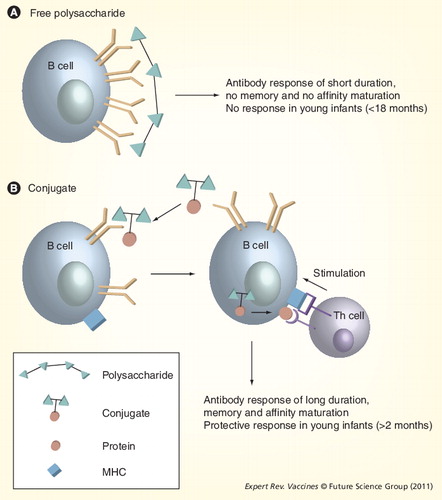Figures & data
Table 1. Immune responses to pneumococcal serotypes in different populations illustrating hyporesponsiveness.
Table 2. Immune responses to pneumococcal serotype 3.

![Figure 2. Contrasting responses following repeated meningococcal C or A polysaccharide vaccine.SBA (rabbit complement) GMTs against serogroup A (A) and C (B) in Gambian infants post-vaccination with MenAC-PS vaccine at 19.7 months or 5 years of age Citation[55,62]. Group MenAC-PS had received prior MenAC-PS at 3 and 6 months; group MenAC-CV+PS had received 1, 2 or 3 prior MenAC-CV doses and MenAC-PS at age 2 years; group MenAC-CV had received 1, 2 or 3 prior MenAC-CV doses and MenAC-PS at year 5. (C) SBA (rabbit complement) GMTs against serogroups A and C in Saudi Arabian 10–29-year olds post MenAC-PS in naive versus previously MenAC-PS-immunized subjects Citation[54]. (D) Percentage of toddlers (from a study conducted in Canada) with serogroup C SBAs ≥1:8 (human complement) after MenACWY-PS Citation[24]. Group MenACWY-PS received MenACWY-PS at study months 0, 2 and 14. Vaccine-naive subjects received MenACWY-PS at month 14. (E) SBA (human complement) GMTs against serogroup C after MenC-PS challenge in naive, MenC-PS or MenC-CV immunized adults Citation[53].CV: Conjugate vaccine; GMT: Geometric mean antibody titer; MenAC: Meningococcal serogroups A and C; MenACYW: Meningococcal serogroup A, C, W-135 and Y; MenC: Meningococcal serogroup C; PS: Polysaccharide; SBA: Serum bactericidal antibodies.Data taken from Citation[24,53–55,62].](/cms/asset/7b7fd299-c9c6-4cb3-b951-9682e292b787/ierv_a_11217495_f0002_b.jpg)
![Figure 3. Effect of prior meningococcal polysaccharide vaccination on responses to meningococcal conjugate vaccine in adolescents.SBA (rabbit complement) GMTs before and after initial meningococcal serogroup A, C, W-135 and Y (MenACWY)-PS vaccination at 14 years of age, and before and after MenACWY-CV booster 3 years later (squares); SBA (rabbit complement) GMTs in vaccine naive subjects after MenACWY-CV at 17 years of age (circles).Error bars represent the 95% CIs.GMT: Geometric mean antibody titer; SBA: Serum bactericidal antibody.Data taken from Citation[56].](/cms/asset/90315e05-3931-4de6-84de-b96aa0c7707c/ierv_a_11217495_f0003_b.jpg)
![Figure 4. Antipneumococcal antibody GMCs (A) and opsonophagocytic activity GMTs (B) in adults ≥70 years of age administered PCV-7 (n = 110) or 23vPn-PS followed 1 year later by PCV-7 (n = 78).Error bars represent the 95% CIs. Differences between the groups were statistically significant (p < 0.01) for all serotypes except OPA titers for serotype 19F.GMC: Geometric mean antibody concentration; GMT: Geometric mean antibody titer; OPA: Opsonophagocytic assay: Pn: Pneumococcal; PS: Polysaccharide.Data taken from Citation[86].](/cms/asset/62b9a0b1-820d-498b-9fe4-e00b144b54ba/ierv_a_11217495_f0004_b.jpg)
![Figure 5. Anti-pneumococcal antibody concentrations (non-22F ELISA) against serotype 3 following 11Pn-PD vaccination in infants.Triangles represent vaccine-naive subjects vaccinated at month 12–15 with 23vPn-PS; Subjects were vaccinated at 2, 4 and 6 months with 11Pn-PD and then boosted at 12–15 months with either 11Pn-PD (represented by circles) or with 23vPn-PS (represented by squares).GMC: Geometric mean antibody concentration.Data taken from Citation[95].](/cms/asset/a1e2862f-186b-47b7-9bfe-2dbe1bf2ed71/ierv_a_11217495_f0005_b.jpg)
